You can help your child develop a healthy spine by scheduling regular chiropractic exams, just as you make regular dental appointments.
Observe your child’s movements and follow these tips:
- When you lift or hold an infant, always support the child’s back and neck with your hands.
- Pick up an older child by grasping his or her body under both arms.
- Never pick up your child by the arms or legs.
- Use an approved car seat that supports your baby’s head and neck.
- Provide a firm bed and chairs.
- Make sure your child gets enough sleep and eats a well-balanced diet.
- Make sure your child wears appropriate protective gear when playing sports.
- If your child uses a backpack, make sure it’s carried over both shoulders.
At Birth
The spine of a newborn is C-shaped, with one curve. A newborn has neither the balancing curves nor the strength to hold his or her head upright. The birth process may be one of the most traumatic events of our lives. Even so-called “natural” birthing methods can stress a still-developing spine. The resulting irritation to the nervous system can be the cause of many newborn health complaints. Colic, unexplained crying, poor appetite, breathing problems, and allergic reactions can often be traced to nervous system dysfunction caused by a malfunctioning spine.
At About Six Months
As your infant lifts his or head during the first few months, the neck (cervical) curve and its muscles develop. Strong neck muscles help an infant hold up a heavy head.
At About Nine Months
As your infant learns to crawl and stand, the lower back (lumbar) curve and its muscles develop. Strong back muscles help give your child the strength and balance to walk and run. Head support, followed by crawling, and a baby’s first few steps should be followed by chiropractic checkups. If neglected, the bumps and falls during this period of rapid growth may lead to serious spinal deformities later in life. This can set the stage for scoliosis, “growing pains,” and a weakened immune system response.
Physical Exam
Your chiropractor will observe your child’s posture and movements, check reflexes and range of motion in the joints, gently palpate the spine, and check for scoliosis (curvature of the spine). The exam should not be painful for your child.
Diagnosis
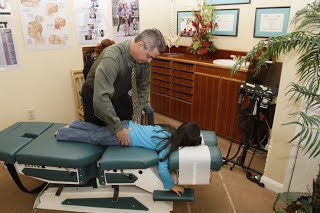 Based on the results of your child’s exam, your doctor of chiropractic may recommend a treatment program to correct any abnormal curvature of the spine, joints or bones that are not moving properly, or loss of flexibility in the spine. If needed, your child’s chiropractor also consults with or refers you to other medical specialists, such as a pediatrician.
Based on the results of your child’s exam, your doctor of chiropractic may recommend a treatment program to correct any abnormal curvature of the spine, joints or bones that are not moving properly, or loss of flexibility in the spine. If needed, your child’s chiropractor also consults with or refers you to other medical specialists, such as a pediatrician.
Why risk your child’s good health during these critical years of development? Now is the time to schedule your child’s spinal exam! You can have confidence that chiropractic is safe and effective care for your little one. When spinal misalignments go untreated, your child’s body continues to grow. An injured spine will simply grow misaligned, leading to degenerative or permanent conditions later in life.
Regular adjustments are an essential ingredient for healthy children! With gentle, expert hands, we can restore your child’s spinal health. Children of all ages can benefit from our expertise in dealing with spinal problems. We see infants dealing with spinal stress from the birth process and toddlers learning to walk. We also see school children active in sports and adolescents going through “growth spurts.”
Chiropractic can be effective in the care of:
- Bed-wetting
- Colic
- Asthma
- Sports Injuries
- Ear Infections
- Headaches
- Allergies
- Some Learning Disabilities
- Neck Pain
- Scoliosis
- Migraines
- Back Pain
With gentle, precise adjustments, chiropractic can restore your child’s misaligned vertebrae into proper position. By eliminating interference now, you could be preventing your child from having future problems down the road!

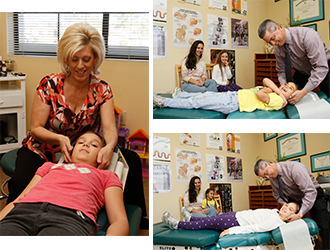 A 1989 study of colicky infants in Denmark reports a success rate of 94% among the study group following a program of chiropractic care. More than two-thirds of all children will have one or more episodes of ear infections by the age of three. A 1996 study of a group of children with ear infections and discomfort found that 93% of the study group reported improvement with chiropractic care. Thousands of children have found relief from bedwetting with chiropractic. Nerve interference due to spinal misalignment can cause the communication between your child’s brain and bladder to break down. Chiropractic care can remove the interference that can cause loss of bladder control.
A 1989 study of colicky infants in Denmark reports a success rate of 94% among the study group following a program of chiropractic care. More than two-thirds of all children will have one or more episodes of ear infections by the age of three. A 1996 study of a group of children with ear infections and discomfort found that 93% of the study group reported improvement with chiropractic care. Thousands of children have found relief from bedwetting with chiropractic. Nerve interference due to spinal misalignment can cause the communication between your child’s brain and bladder to break down. Chiropractic care can remove the interference that can cause loss of bladder control.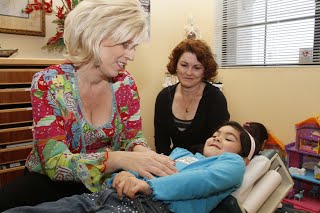 How Does My Baby’s Spine Develop?
How Does My Baby’s Spine Develop? Based on the results of your child’s exam, your doctor of chiropractic may recommend a treatment program to correct any abnormal curvature of the spine, joints or bones that are not moving properly, or loss of flexibility in the spine. If needed, your child’s chiropractor also consults with or refers you to other medical specialists, such as a pediatrician.
Based on the results of your child’s exam, your doctor of chiropractic may recommend a treatment program to correct any abnormal curvature of the spine, joints or bones that are not moving properly, or loss of flexibility in the spine. If needed, your child’s chiropractor also consults with or refers you to other medical specialists, such as a pediatrician.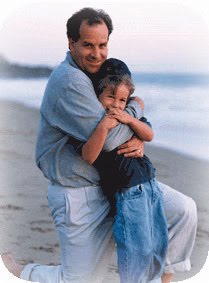 Hyperactivity, learning disorders, bed-wetting, and other health problems may be the result of nervous system interference or malfunction caused by spine-related problems. Appropriate chiropractic care can help locate and correct these problems and restore normal spinal and nervous system function.
Hyperactivity, learning disorders, bed-wetting, and other health problems may be the result of nervous system interference or malfunction caused by spine-related problems. Appropriate chiropractic care can help locate and correct these problems and restore normal spinal and nervous system function.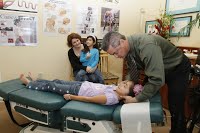 Disorders such as Down Syndrome, mental retardation, bacteriological infections, traumatic birth, including lack of oxygen or hemorrhage, affect the central nervous system. Many of these conditions affect the brain stem that extends into the cervical spine.
Disorders such as Down Syndrome, mental retardation, bacteriological infections, traumatic birth, including lack of oxygen or hemorrhage, affect the central nervous system. Many of these conditions affect the brain stem that extends into the cervical spine.